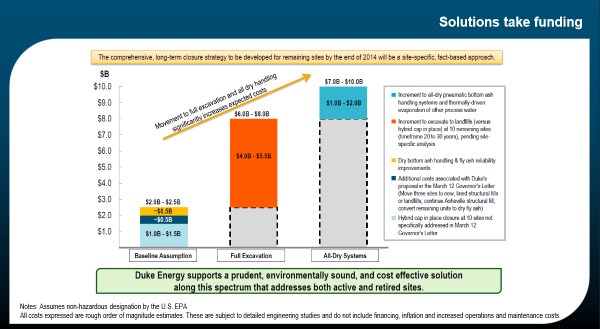August 2, 2014. Senate Bill 729 (Coal Ash Management Act of 2014) hit a wall this week when the conference committee trying to resolve differences between House and Senate versions of the bill failed to reach agreement and the Senate adjourned for a two-week recess. (The House adjourns today following a final budget vote.) The General Assembly returns on August 14, although the Senate’s adjournment resolution suggests the coal ash bill may not be eligible for consideration then. It may be November before the General Assembly takes up coal ash legislation again.
House and Senate versions of the bill differed in several ways (such as appointments to the Coal Ash Management Commission), but negotiations apparently blew up over a new issue. House negotiators became concerned that the bill’s provisions on closure of coal ash impoundments could allow coal ash in close proximity to groundwater to be “capped in place” and remain a source of ongoing groundwater contamination. “Closure” means final cleanup and restoration of the impoundment site under environmental standards. “Capping in place” refers to a closure method that allows the coal ash to be dewatered and then covered by a layer of low-permeability soil (such as clay) to reduce infiltration of rainwater. Another layer of soil on top of the clay cap provides a base for vegetation to stabilize the site and prevent erosion.
Capping the dewatered coal ash on site avoids the expense of moving the coal ash for disposal in an industrial landfill. Although Duke Energy has said the company has no bias in favor of capping in place (other than the lower cost), company representatives have stressed to legislators the high cost of removing all of the coal ash from impoundments at 14 electric generation sites in North Carolina (some operational and others closed). Duke Energy’s State President for North Carolina, Paul Newton, used the graph below in an April presentation to the legislature’s Environmental Review Commission. The graph shows a “baseline” cost of approximately $2.5 billion dollars to close impoundments at all 14 sites and convert to dry ash handling. The baseline estimate assumes that Duke Energy will entirely remove the coal ash at four facilities (Dan River, Riverbend, Asheville and Sutton) and use capping in place at the other ten facilities. Duke Energy estimated the cost of removing coal ash from all 14 facilities to be $10 billion.
(Duke Energy’s cost estimates are provided to give a sense of the utility’s message to legislators and not to validate the numbers.) Mr. Newton’s entire presentation can be found here.
Negotiation of Senate Bill 729 broke down over the House conferees’ insistence on language that would put additional limits on capping in place. S 729 requires coal ash in impoundments prioritized by DENR as high risk or intermediate risk to be removed and either placed in a lined industrial landfill or put to an approved beneficial reuse. The bill allows low risk impoundments to be closed by capping in place under the same standard applied to closure of a municipal solid waste landfill. But unlike landfills, coal ash impoundments were not required to have a liner and maintain a minimum separation (in feet) between the lowest level of waste and groundwater. House negotiators became concerned that an impoundment with coal ash in close proximity to groundwater could be classified as low risk under the bill — allowing the coal ash to be capped in place and continue leaching contaminants into groundwater through direct contact with the water table.
House conferees proposed language to prevent the use of capping in place to close impoundments below the seasonal high water table – by either excluding those impoundments from the low risk category completely or by changing standards for closure of low risk impoundments to allow capping in place only at impoundments located above the seasonal high water table. Senate conferees agreed to add proximity of coal ash to groundwater as another factor in prioritizing impoundments for closure, but rejected House language to prevent a “cap in place” closure of coal ash in impoundments below the seasonal high water table. House conferees refused to accept a bill without assurance that groundwater would be protected from ongoing contamination by coal ash in the water table.
Senate conferees prepared and signed a conference report including only the changes in S 729 acceptable to the Senate. House conferees prepared an alternative conference report. The Senate then adjourned without final action on the Coal Ash Management Act of 2014.
Update (1:30 p.m.) The legislative session will continue until at least early next week because of lack of agreement on the adjournment resolution. The House modified the adjournment resolution adopted by the Senate to allow more bills to be considered during the August 14 session (including coal ash). The Senate, having already gone home, has not voted on the modified adjournment resolution so session continues. Senate will reconvene on August 5 at 10:00 a.m. and the House on August 6 at 12:00 p.m. Whether the two bodies will do anything next week beyond agree on an adjournment resolution remains to be seen.


DUKE Energy,
Dude quit whining & crying to your political pals. Pull up your big boy, deep pocketed pants and clean up your coal ash mess.